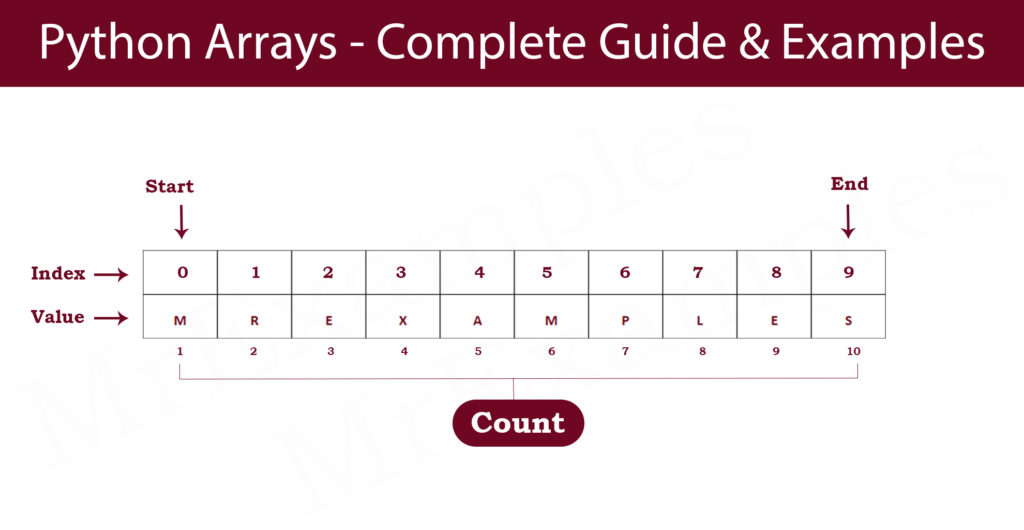Python Arrays
Python arrays are explained here with examples to help fulfill educational requirements.

Note: The Python language does not support Arrays, but Python Lists can be used in their place.
What is Array?
A Python array is a special variable that can hold multiple values at once.
Suppose you have a list of items (such as firm names), you could store all firms as single variables as below:
firm2 = “Apple Inc”
firm3 = “Google”
What if you want to find a specific firm by looping through them? Could you imagine having hundreds of firm names rather than just five? An array is the solution!
When it comes to Python arrays, you can get the values by referring to an index number.
Arrays In Python
To work with Python arrays, you will need to import a library, such as the NumPy library, which shows how to use LISTS as ARRAYS.
An array can hold multiple values in a single variable:
Example: Array containing firm names
Adding Array Elements
Array elements can be added using the append() method.
The firms array now has one more element:
Example
Removing Array Elements
Array elements can be removed using the pop() method.
Remove the third item from the array of firms:
Example
The remove() method can also be used to remove item from an array.
Delete the item with the value “BlackRock”:
Example
Note: It is important to understand that the list’s remove() method will only remove the first occurrence of the selected value.
Looping Array Elements
When it comes to Python arrays, you can loop through all the elements using the for in loop.
Array of firms:
Example
Array Element Access
The index number of an array element is what we refer to when we talk about Python arrays.
Find the value of the second array item:
Example
Change the value of the third array item as follows:
Example
An array’s length
Return the length of an array using the len() method (the number of elements in an array).
Find out how many elements there are in the firms array:
Example
The length of an array is always one greater than its highest index.
Array Methods
You can use several built-in methods to work with Python arrays and lists in Python.
| Method | Overview |
|---|---|
| append() |
Lists an element at the end. |
| clear() |
All elements in the list are removed. |
| copy() |
The list is returned as a copy. |
| count() |
This function returns the number of elements with the specified value. |
| extend() |
List elements (or any iterable) are added to the current list. |
| index() |
Indicates which element has the specified value as its first element. |
| insert() |
Positions an element at the given location. |
| pop() |
Elements at the selected position are removed. |
| remove() |
Delete the first item with the specified value. |
| reverse() |
Lists are reversed. |
| sort() |
Lists are sorted. |
Important: It is important to note that Python does not support Arrays directly but keeps Python Lists.
Python Arrays Importance
- Arrays in Python provide an efficient way to store and access a collection of elements. Compared to lists, arrays consume less memory and provide faster access to elements, especially when dealing with large amounts of data.
- Arrays are particularly useful for numerical computations and scientific computing. The NumPy library in Python provides a powerful array object called
ndarray, which enables efficient manipulation and computations on arrays of numeric data. Arrays allow for vectorized operations, which can significantly improve performance compared to traditional iterative operations. - Arrays enforce homogeneous data types, meaning that all elements in an array must be of the same type. This allows for efficient storage and processing of data with a uniform structure, such as arrays of integers, floating-point numbers, or boolean values.
- Arrays can be used to represent and work with multidimensional data, such as matrices or tensors. This makes arrays suitable for tasks involving image processing, machine learning, data analysis, and scientific simulations, where data is often represented in multiple dimensions.
- Arrays seamlessly integrate with various external libraries in Python, such as NumPy, Pandas, and scikit-learn. These libraries provide extensive support for array operations and offer a wide range of functions and methods for data manipulation, analysis, and modeling. Arrays serve as the foundation for many of these libraries, making them a fundamental data structure for scientific and data-intensive applications.
